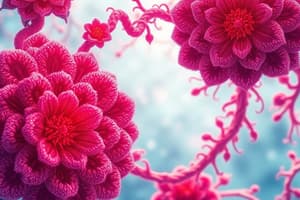Podcast
Questions and Answers
Which characteristic is NOT universally shared by all living organisms?
Which characteristic is NOT universally shared by all living organisms?
- Organization at a cellular level
- Metabolism to acquire energy
- Reproduction through sexual means (correct)
- Response to stimuli
How does the study of anatomy relate to the study of physiology?
How does the study of anatomy relate to the study of physiology?
- Anatomy studies the structures of the body, while physiology studies the functions of those structures. (correct)
- Physiology is a branch of anatomy.
- Anatomy and physiology are unrelated fields of study.
- Anatomy focuses on function, while physiology focuses on structure.
Which level of structural organization is exemplified when different tissues combine to perform a specific task?
Which level of structural organization is exemplified when different tissues combine to perform a specific task?
- System level
- Tissue level
- Cellular level
- Organ level (correct)
Which organ system is responsible for the transport of nutrients and waste throughout the body?
Which organ system is responsible for the transport of nutrients and waste throughout the body?
Which anatomical term is the opposite of 'superior'?
Which anatomical term is the opposite of 'superior'?
Which of the following is the correct anatomical term for 'front'?
Which of the following is the correct anatomical term for 'front'?
What plane would you use to separate the brain into a front and back portion?
What plane would you use to separate the brain into a front and back portion?
A doctor orders an MRI to view a slice of the brain to check for abnormalities. The MRI produces an image dividing the brain into top and bottom portions. Which plane was the MRI aligned to?
A doctor orders an MRI to view a slice of the brain to check for abnormalities. The MRI produces an image dividing the brain into top and bottom portions. Which plane was the MRI aligned to?
Why is maintaining homeostasis important for living organisms?
Why is maintaining homeostasis important for living organisms?
Consider an injury located distally on the arm. Where would you find it?
Consider an injury located distally on the arm. Where would you find it?
Which system is responsible for defending the body against infection and disease?
Which system is responsible for defending the body against infection and disease?
In which structural level does the stomach belong?
In which structural level does the stomach belong?
What field of biology specifically studies heredity and variation in organisms?
What field of biology specifically studies heredity and variation in organisms?
If someone is experiencing issues related to hormone production, which organ system is likely involved?
If someone is experiencing issues related to hormone production, which organ system is likely involved?
Using anatomical directional terms, the heart is considered what to the lungs?
Using anatomical directional terms, the heart is considered what to the lungs?
A patient complains of pain on the surface of their skin; the doctor would say this is a ____ issue.
A patient complains of pain on the surface of their skin; the doctor would say this is a ____ issue.
What is the correct anatomical position?
What is the correct anatomical position?
Which of the following is NOT a function of the skeletal system?
Which of the following is NOT a function of the skeletal system?
What is the basic unit of heredity?
What is the basic unit of heredity?
Which of the following best describes the study of ecology?
Which of the following best describes the study of ecology?
Flashcards
What is Biology?
What is Biology?
The scientific study of life, including its structure, function, growth, origin, evolution, and distribution.
What is Homeostasis?
What is Homeostasis?
Maintains a stable internal environment despite external changes, essential for survival.
What is a Cell?
What is a Cell?
The basic unit of life, responsible for carrying out all life processes.
What is Biochemistry?
What is Biochemistry?
Signup and view all the flashcards
What is Botany?
What is Botany?
Signup and view all the flashcards
What is Ecology?
What is Ecology?
Signup and view all the flashcards
What is Evolutionary Biology?
What is Evolutionary Biology?
Signup and view all the flashcards
What is Genetics?
What is Genetics?
Signup and view all the flashcards
What is Microbiology?
What is Microbiology?
Signup and view all the flashcards
What is Physiology?
What is Physiology?
Signup and view all the flashcards
What is Zoology?
What is Zoology?
Signup and view all the flashcards
What is Human Anatomy?
What is Human Anatomy?
Signup and view all the flashcards
What is the Chemical Level?
What is the Chemical Level?
Signup and view all the flashcards
What are Tissues?
What are Tissues?
Signup and view all the flashcards
What is an Organ?
What is an Organ?
Signup and view all the flashcards
What is a System?
What is a System?
Signup and view all the flashcards
What is the Integumentary System?
What is the Integumentary System?
Signup and view all the flashcards
What is the Skeletal System?
What is the Skeletal System?
Signup and view all the flashcards
What is the Nervous System?
What is the Nervous System?
Signup and view all the flashcards
What is Superior (cranial)?
What is Superior (cranial)?
Signup and view all the flashcards
Study Notes
- Biology is the scientific study of life.
- It explores the structure, function, growth, origin, evolution, and distribution of living organisms.
- Biology recognizes the cell as the basic unit of life, genes as the basic unit of heredity, and evolution as the engine that propels the creation and extinction of species.
- Living organisms must maintain homeostasis to survive.
- All living organisms share several key characteristics, including organization, metabolism, reproduction, growth, and response to stimuli.
Subdisciplines of Biology
- Biochemistry studies the chemical processes within and relating to living organisms.
- Botany studies plants, including their physiology, structure, genetics, ecology, distribution, classification, and economic importance.
- Cell biology studies the structure, function, and behavior of cells.
- Ecology studies the interactions of organisms with each other and with their environment.
- Evolutionary biology studies the origin and descent of species, as well as their changes over time.
- Genetics studies heredity and variation in organisms.
- Microbiology studies microorganisms, including bacteria, viruses, fungi, and protozoa.
- Molecular biology studies the molecular basis of biological activity.
- Physiology studies the functions and mechanisms of living organisms and their parts.
- Zoology studies animals, including their physiology, anatomy, behavior, genetics, ecology, evolution, and classification.
Human Anatomy
- Human anatomy studies the structure of the human body.
- It includes the study of individual organs and systems.
- Anatomy is closely related to physiology, which studies the function of the body's structures.
Levels of Organization
- The human body is organized in a hierarchical manner.
- Chemical level: atoms and molecules
- Cellular level: cells are the basic units of life
- Tissue level: tissues are groups of similar cells performing a specific function
- Organ level: organs are composed of two or more different tissues
- System level: organ systems consist of different organs that work together closely
- Organismal level: the human organism is the sum total of all structural levels working together to keep us alive
Organ Systems
- Integumentary system: skin, hair, and nails; protects the body and regulates temperature
- Skeletal system: bones, cartilage, and joints; provides support and facilitates movement
- Muscular system: skeletal muscles; enables movement, maintains posture, and produces heat
- Nervous system: brain, spinal cord, and nerves; controls and coordinates bodily functions
- Endocrine system: glands that secrete hormones; regulates growth, reproduction, and metabolism
- Cardiovascular system: heart and blood vessels; transports blood, oxygen, and nutrients
- Lymphatic system: lymphatic vessels and lymphoid tissues; defends against infection and disease
- Respiratory system: lungs and airways; exchanges gases between the body and the environment
- Digestive system: mouth, esophagus, stomach, intestines, liver, and pancreas; breaks down food and absorbs nutrients
- Urinary system: kidneys, ureters, bladder, and urethra; eliminates waste and regulates water balance
- Reproductive system: gonads and associated organs; enables reproduction
Anatomical Terminology
- Anatomical position: standard reference point, body erect, feet slightly apart, palms facing forward.
- Superior (cranial): toward the head end or upper part of a structure or the body; above.
- Inferior (caudal): away from the head end or toward the lower part of a structure or the body; below.
- Anterior (ventral): toward or at the front of the body; in front of.
- Posterior (dorsal): toward or at the back of the body; behind.
- Medial: toward or at the midline of the body; on the inner side of.
- Lateral: away from the midline of the body; on the outer side of.
- Proximal: closer to the origin of the body part or the point of attachment of a limb to the body trunk.
- Distal: farther from the origin of a body part or the point of attachment of a limb to the body trunk.
- Superficial (external): toward or at the body surface.
- Deep (internal): away from the body surface; more internal.
Body Planes
- Sagittal plane: divides the body into right and left parts.
- Midsagittal (median) plane: sagittal plane that lies exactly in the midline.
- Frontal (coronal) plane: divides the body into anterior and posterior parts.
- Transverse (horizontal) plane: divides the body into superior and inferior parts.
Studying That Suits You
Use AI to generate personalized quizzes and flashcards to suit your learning preferences.




